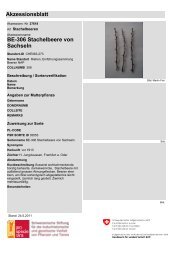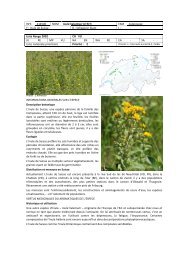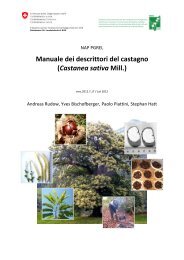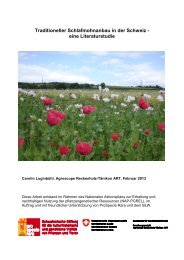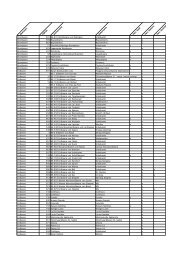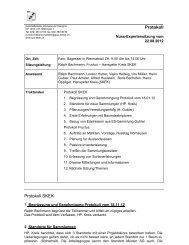- Seite 1 und 2:
Schweizerische Kommission für die
- Seite 3 und 4:
1. Aufgabe Entstehung: Die SKEK-Ges
- Seite 5 und 6:
3. Welches sind die nächsten Schri
- Seite 7 und 8:
agronomische Forschung zur Wissensv
- Seite 9 und 10:
CWR Inventar Welches sind die mit K
- Seite 11 und 12:
CWR Inventar 2. Methode: Die hier b
- Seite 13 und 14:
CWR Inventar 2.2. CWR of Switzerlan
- Seite 15 und 16:
CWR Inventar 2.3. Liste der Zierpfl
- Seite 17 und 18:
32% 10% 2% 4% Abbildung 8: CWR Arte
- Seite 19 und 20:
2% 20% 45% 1% 4% Abbildung 11: Gef
- Seite 21 und 22:
CWR Inventar Es ist auffallend, das
- Seite 23 und 24:
CWR Inventar 4.11. Berner Konventio
- Seite 25 und 26:
CWR Inventar „Ernährung und Land
- Seite 27 und 28:
CWR Inventar 7. Abbildungsverzeichn
- Seite 29 und 30:
NO_ISFS CWR der Schweiz STATUT_NOM
- Seite 31 und 32:
NO_ISFS CWR der Schweiz STATUT_NOM
- Seite 33 und 34:
NO_ISFS CWR der Schweiz STATUT_NOM
- Seite 35 und 36:
NO_ISFS CWR der Schweiz STATUT_NOM
- Seite 37 und 38:
NO_ISFS CWR der Schweiz STATUT_NOM
- Seite 39 und 40:
NO_ISFS CWR der Schweiz STATUT_NOM
- Seite 41 und 42:
NO_ISFS CWR der Schweiz STATUT_NOM
- Seite 43 und 44:
NO_ISFS CWR der Schweiz STATUT_NOM
- Seite 45 und 46:
NO_ISFS CWR der Schweiz STATUT_NOM
- Seite 47 und 48:
NO_ISFS CWR der Schweiz STATUT_NOM
- Seite 49 und 50:
NO_ISFS CWR der Schweiz STATUT_NOM
- Seite 51 und 52:
NO_ISFS CWR der Schweiz STATUT_NOM
- Seite 53 und 54:
NO_ISFS CWR der Schweiz STATUT_NOM
- Seite 55 und 56:
NO_ISFS CWR der Schweiz STATUT_NOM
- Seite 57 und 58:
NO_ISFS CWR der Schweiz STATUT_NOM
- Seite 59 und 60:
NO_ISFS CWR der Schweiz STATUT_NOM
- Seite 61 und 62:
Kulturpflanzen (NAP - sozi-ökonomi
- Seite 63 und 64:
Gemüse Beeren Futterpflanzen Aroma
- Seite 65 und 66:
Gemüse Beeren Futterpflanzen Aroma
- Seite 67 und 68:
Gemüse Beeren Futterpflanzen Aroma
- Seite 69 und 70:
Inhaltverzeichnis 1. Einleitung p2
- Seite 71 und 72:
Crop Wild Relatives (CWR) der Schwe
- Seite 73 und 74:
Prioritäre CWR Arten 4.2. Für wel
- Seite 75 und 76:
Prioritäre CWR Arten 4.4. Zucht un
- Seite 77 und 78:
Prioritäre CWR Arten 5. Diskussion
- Seite 79 und 80:
Legende prioritäre CWR der Schweiz
- Seite 81 und 82:
ZDSF-Nr Gemüse PLAM Futterpflanzen
- Seite 83 und 84:
ZDSF-Nr Gemüse PLAM Futterpflanzen
- Seite 85 und 86:
ZDSF-Nr Gemüse PLAM Futterpflanzen
- Seite 87 und 88:
PLAM Futterpflanzen Ackerpflanzen O
- Seite 89 und 90:
Schweizerische Kommission für die
- Seite 91 und 92:
Schweizerische Kommission für die
- Seite 93 und 94:
PLAM Futterpflanzen Ackerpflanzen O
- Seite 95 und 96:
PLAM Futterpflanzen Ackerpflanzen O
- Seite 97 und 98:
PLAM Futterpflanzen Ackerpflanzen O
- Seite 99 und 100:
PLAM Futterpflanzen Ackerpflanzen O
- Seite 101 und 102:
PLAM Futterpflanzen Ackerpflanzen O
- Seite 103 und 104:
PLAM Futterpflanzen Ackerpflanzen O
- Seite 105 und 106:
PLAM Futterpflanzen Ackerpflanzen O
- Seite 107 und 108:
PLAM Futterpflanzen Ackerpflanzen O
- Seite 109 und 110:
PLAM Futterpflanzen Ackerpflanzen O
- Seite 111 und 112:
PLAM Futterpflanzen Ackerpflanzen O
- Seite 113 und 114:
PLAM Futterpflanzen Ackerpflanzen O
- Seite 115 und 116:
PLAM Futterpflanzen Ackerpflanzen O
- Seite 117 und 118:
PLAM Futterpflanzen Ackerpflanzen O
- Seite 119 und 120:
PLAM Futterpflanzen Ackerpflanzen O
- Seite 121 und 122:
PLAM Futterpflanzen Ackerpflanzen O
- Seite 123 und 124:
PLAM Futterpflanzen Ackerpflanzen O
- Seite 125 und 126:
PLAM Futterpflanzen Ackerpflanzen O
- Seite 127 und 128:
Handlungsbedarf 1. Einleitung Das v
- Seite 129 und 130:
Handlungsbedarf Ziel A) Die Vielfal
- Seite 131 und 132:
Handlungsbedarf 2.7. Weitere Aktion
- Seite 133 und 134:
Handlungsbedarf 4. Handlungsbedarf
- Seite 135 und 136:
Handlungsbedarf und der genetischen
- Seite 137 und 138:
Handlungsbedarf Es war nicht Ziel d
- Seite 139 und 140:
Ressources génétiques dans le gen
- Seite 141 und 142:
Résumé Brassica rapa subsp. campe
- Seite 143 und 144:
1. Informations générales 1.1. La
- Seite 145 und 146:
1.3. Le genre Brassica - un trésor
- Seite 147 und 148:
Le Tableau 3 présente les différe
- Seite 149 und 150:
Sous-espèces de B. rapa A côté d
- Seite 151 und 152:
éteinte en de multiples endroits a
- Seite 153 und 154:
1888) et récoltée pour les premie
- Seite 155 und 156:
Figure 4. Analyse en coordonnées p
- Seite 157 und 158:
Trois directions du flux de gènes
- Seite 159 und 160:
égions. A Guarda par exemple, tout
- Seite 161 und 162:
Rotation des cultures alternant cé
- Seite 163 und 164:
(9) introduire en culture ex-situ l
- Seite 165 und 166:
Janchen E. 1956-1960. Catalogus Flo
- Seite 167 und 168:
Commission suisse pour la conservat
- Seite 169 und 170:
Etude de cas pour le projet CWR de
- Seite 171 und 172:
Le milieu de prédilection du Pois
- Seite 173 und 174:
Etude de cas pour le projet CWR de
- Seite 175 und 176:
Conservation in situ et plan d’ac
- Seite 177 und 178:
Etude de cas pour le projet CWR de
- Seite 179 und 180:
CONCLUSION Etude de cas pour le pro
- Seite 181 und 182:
Vorprojekt Erhaltung von Crop Wild
- Seite 183 und 184:
Vorprojekt Erhaltung von Crop Wild
- Seite 185 und 186:
Vorprojekt Erhaltung von Crop Wild
- Seite 187 und 188:
Vorprojekt Erhaltung von Crop Wild
- Seite 189 und 190:
Vorprojekt Erhaltung von Crop Wild
- Seite 191 und 192:
Vorprojekt Erhaltung von Crop Wild
- Seite 193 und 194:
Vorprojekt Erhaltung von Crop Wild
- Seite 195 und 196: Vorprojekt Erhaltung von Crop Wild
- Seite 197 und 198: Vorprojekt Erhaltung von Crop Wild
- Seite 199 und 200: Vorprojekt Erhaltung von Crop Wild
- Seite 201 und 202: Vorprojekt Erhaltung von Crop Wild
- Seite 203 und 204: Vorprojekt Erhaltung von Crop Wild
- Seite 205 und 206: Vorprojekt Erhaltung von Crop Wild
- Seite 207 und 208: Vorprojekt Erhaltung von Crop Wild
- Seite 209 und 210: Vorprojekt Erhaltung von Crop Wild
- Seite 211 und 212: Schweizerische Kommission für die
- Seite 213 und 214: Prioritäre CWR-Artenliste In der p
- Seite 215 und 216: Schweizerische Kommission für die
- Seite 217 und 218: Liebe Kolleginnen, Liebe Kollegen,
- Seite 219 und 220: Schweizerische Kommission für die
- Seite 221 und 222: Schweizerische Kommission für die
- Seite 223 und 224: Schweizerische Kommission für die
- Seite 225 und 226: Geschäftsstelle, Domaine de Changi
- Seite 227 und 228: Geschäftsstelle, Domaine de Changi
- Seite 229 und 230: Schweizerische Kommission für die
- Seite 231 und 232: Schweizerische Kommission für die
- Seite 233 und 234: Schweizerische Kommission für die
- Seite 235 und 236: Geschäftsstelle, Domaine de Changi
- Seite 237 und 238: Geschäftsstelle, Domaine de Changi
- Seite 239 und 240: Schweizerische Kommission für die
- Seite 241 und 242: Promoting conservation: the SPIMED
- Seite 243 und 244: Current distribution of Avena strig
- Seite 245: Threat Threats are documented at tw
- Seite 249: Threats Major threats to L. hispani



